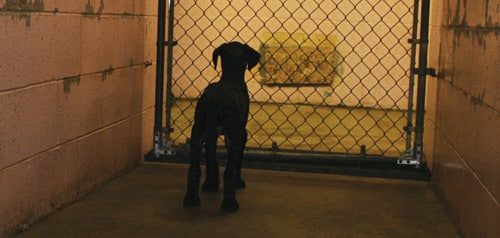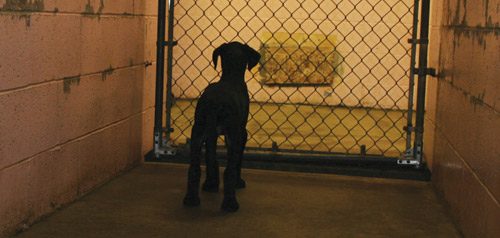

Give Me Shelter
Second chances slim for abandoned animals
Writer’s note: For three years I have ghostwritten for the Whatcom Humane Society (WHS), an organization on the front lines of animal rescue. The stories of the animals arriving at WHS are repeated in shelters across the U.S. and Canada with only the names and dates changing. The heroes working and volunteering at animal shelters do their best to save these abandoned pets in the face of a staggering overpopulation crisis caused by human irresponsibility.
In their seven years, Brewster and Brandi’s biggest crime was to miss their human guardians too much. Left alone in the backyard most of the time, separation anxiety set in for the Beagle brother and sister. Craving the companionship of the pack, the Beagles bayed in the sharp timbre that earned their breed a history of hunting duty.
Neighbours complained about the howling, and two weeks before Christmas, their owner had enough of their lonely cries. The Beagles were dropped off at the Whatcom Humane Society (WHS) in northern Washington State, and any interest in their care or future was surrendered with a single signature on an intake page.
Like most animals landing at community animal shelters, the details of Brewster and Brandi’s lives are sketchy. In their cement kennel, the two dogs bonded since birth move like shadows of each other. One mature Beagle would be difficult to place, but a bonded pair is nearly impossible. At the WHS front desk, customer service staff member Christa DeLano reports that a Beagle purebred rescue group has been notified about Brewster and Brandi’s arrival, but like animal rescue groups everywhere, they are usually full.
“I never realized until I worked here how many people surrender animals,” says Jessie Pitts, who also works the front desk. “They come in all shapes and sizes.”
Whatcom Humane Society, located near the Bellingham International Airport, has animal control contracts with local governments to serve a population of about 85,000 people, but the shelter will accept animals surrendered from owners living anywhere. In 2006, almost 3,300 animals were accepted into the tiny, dilapidated facility staffed by 16 people. The non-profit organization is assisted by 75 volunteers. The kennels have no access to sunshine or fresh air, and barking dogs blast out a cacophony of noise. Areas for exercising and socializing animals are nearly non-existent. Most animal shelters (including WHS) receive no government funding with the exception of what amounts to break-even animal control contracts. They depend entirely on donations to survive.
WHS is an open-door shelter accepting every animal without considering his or her age, health, physical condition, and temperament. The agency’s space limitations also aren’t a factor. That means making hard choices: euthanize animals, or risk warehousing them indefinitely.
“We put people in solitary confinement for murder,” says WHS executive director Penny Cistaro. “How can you call that humane treatment for an animal?”
The harsh reality is that there is a drastic shortage of homes for unwanted companion animals. Statistics aren’t reliably compiled and tabulated, but animal welfare groups estimate the number of animals euthanized annually to be as many as nine million.
Animals are surrendered to shelters for a variety of mostly trivial reasons; at WHS, moving is the most popular reason cited. Like swinging by to drop an old couch at the garbage dump, dogs, cats, and other pets are left at the shelter on the way to the next destination. A minor requirement such as paying a pet damage deposit might motivate a citizen to relinquish a companion animal. Not having enough time for a pet is also a popular excuse, even for those turning over cats requiring little more than food and shelter, DeLano says.
“There’s a constant barrage of animals being dumped for various reasons,” says Laura Clark, WHS community outreach and humane education director. “It’s not getting better.”
Clark, a 10-year veteran of shelter work, remembers feeling shell-shocked after her first interview at a large San Francisco Bay-area shelter. “I cried all the way home, but I knew this was the only thing I wanted to do,” she says.
Director Cistaro, who has worked in animal sheltering for 32 years, says it was the first few animals in severe distress she encountered early in her career as a young field officer that made a stark impression on her. They helped her realize death wasn’t the worst fate that could befall an animal. “I have seen the worst things happen to homeless and stray animals, and I have seen the pain, torture, suffering, and anguish.”
Cistaro says it’s a daily battle for shelters to fight against “hungry puppy syndrome,” referring to the phenomenon of getting so caught up in feeding and caring for an overwhelming and endless torrent of homeless animals that little time is left to dedicate to fundamental community outreach: spaying and neutering, raising money, humane education, and programs teaching children and adults that animals are sentient beings deserving of respect and compassion.
The importance of community outreach programs, particularly the low-cost Spay Neuter Assistance Program, is illustrated by the shelter’s new arrivals. As Christmas descends on WHS, seven Pit Bull-mix eight-week-old puppies are dropped off. The litter is so large—11 in all—that staff name them after Santa’s reindeer: Cupid, Comet, Vixen, Dasher, Dancer, Prancer, and Blitzen.
The pups aren’t socialized. Volunteers like Katy James show great patience and dedication, spending many hours sitting on the floor of their kennel playing, petting, reassuring. In just one week they are clamoring to the front of the cage to get closer to visitors. One by one they are adopted.
Still, staff members and volunteers agree “it’s an emotionally and physically taxing job. There’s not a day you don’t go home mentally and physically exhausted,” Clark says. Salaries are low, and statistics show that the burn-out rate is high, especially within the first one to two years on the job.
Even the volunteers feel the toll at times. “There are days when we all take turns crying,” says Lynn Graham, who spends two days a week volunteering at the shelter.
Difficult decisions are made almost every day. The shelter is already overloaded when the 17th cat comes through the doors carried in a taped-up Home Depot box. Her previous owners apparently sold their house and left her behind three weeks earlier.
The 13-year-old cat doesn’t get checked into a kennel – it would only prolong the inevitable. There are none left anyway, and the reality is that an older cat can’t compete for the few available homes. Potential adopters fear veterinary bills and the prospect of having to say goodbye in only a few short years. Instead she is taken down the hall to a small modest room painted peach, where she is put down. There is nowhere else for her to go.
“She died a very peaceful death,” Clark says of the cat, acknowledging that tough calls like this one are made by shelter workers every day. “Somebody in some shelter somewhere is kneeling over a cat like this right now. Sometimes the only thing we can do is be there at the animal’s final moment.”
Against all odds, however, Beagles Brandi and Brewster are going to make it. Clark took them to Bellingham’s KAFE radio station where the dogs appeared with her on the popular KAFE Kritters spot. For rescued animals, the show is the equivalent of the Holy Grail. KAFE radio personalities Shari Matthews and Dave Walker are animal lovers and avid supporters of the shelter’s efforts, and have taken on Brandi and Brewster’s cause. They will publicize the Beagles’ plight on-air until a listener steps forward to offer them a home together.
It is happy endings and public support such as this that keep the shelter staff going. It’s a job that would defeat many animal lovers, but the successes inspire the workers and volunteers to press on. A call to shelter staff from the family of Pepper, a 115-pound Chow adopted the previous day, proclaims she is thriving in her new home. A picture of Sarah, the large mixed-breed dog adopted recently after spending eight months at the shelter, is posted in the lobby. Sarah’s head is poking out the window and her ears are flying in the wind as she takes off in her new owner’s car. Holiday cards with photographs enclosed from adopters buoy the spirits of the staff who focus on the second chances given to forgotten animals.
And not all visitors are surrendering family pets. One woman stopped by to donate $750 of supplies including beds, food and toys for the animals, causing the staff to marvel at her generosity.
“I find this to be an inspiring place,” Clark says. “I don’t find it to be sad.”
Carreen Maloney was a journalist in Canada for 10 years at the Ottawa Citizen, the Winnipeg Free Press and Business in Vancouver. She has rescued animals for 15 years. She writes about animals and runs Fuzzy Town, a U.S.-based toy and pet products company. She can be contacted at carreen@fuzzytown.com.
Join the newsletter and never miss out on dog content again!
"*" indicates required fields
By clicking the arrow, you agree to our web Terms of Use and Privacy & Cookie Policy. Easy unsubscribe links are provided in every email.